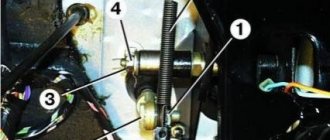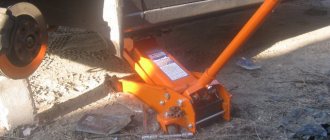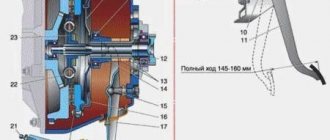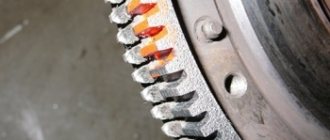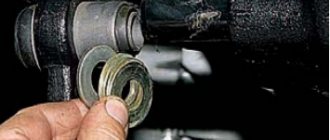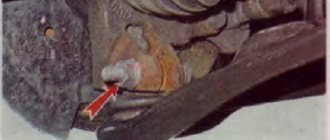Repair kit GAZ-3110,3302 gearbox: simple repair of the Volga, GAZelle and Sobol gearboxes
September 19, 2014
To repair individual components and assemblies of cars, repair kits are used, which greatly facilitate the task of purchasing all the necessary parts. Repair kits are also widely used for repairing gearboxes of GAZ cars - these repair kits, their composition and types, as well as applicability and manufacturers are described in detail in this article.
Purpose of repair kits for gearboxes of GAZ vehicles
GAZ cars and trucks of the Volga, GAZelle, Sobol and Barguzin families use a single model range of manual transmissions, which, unfortunately, cannot boast of high operational reliability. This especially applies to commercial trucks - the gearboxes in them are subject to significant loads during active use, as a result of which many parts quickly exhaust their service life. Therefore, owners of cars from the Gorky Automobile Plant are forced to periodically repair the gearbox and many other units.
Typically, gearbox repair comes down to replacing the most worn parts - gears, but cuffs, bearings, rollers, washers and other parts are almost always replaced along with them. Also, when repairing a gearbox, it is always necessary to replace the gaskets, which after removal cannot be reused.
Thus, with almost every repair of the gearbox of GAZ vehicles, the need for bearings, washers, cuffs and gaskets arises. Today, all these parts can be bought in a set - they are part of repair kits designed specifically for repairing GAZ gearboxes. The repair kit greatly facilitates repairs; it eliminates the need to go shopping and buy small parts separately, which means it allows you to repair or carry out maintenance of the gearbox much faster and at lower costs.
- 5 375 ₽
- 1 590 ₽
- 3 740 ₽
- 3 930 ₽
- 2 295 ₽
- 4 460 ₽
- 1 780 ₽
- 2 150 ₽
- 780 ₽
- 2 780 ₽
Show all products
Today, several types of repair kits for GAZ gearboxes are produced, which differ in their purpose:
- Small repair kits for gearboxes;
- Large repair kits for gearboxes;
- Repair kits for the secondary shaft of the gearbox;
- Repair kits for gearbox lever housing.
The composition of the repair kit depends on its type. Small and large repair kits are designed for general gearbox repairs, so they contain the largest number of parts: needle and ball bearings for various purposes (primary, intermediate and secondary shafts, crankshaft, etc.), rollers, cuffs, gaskets, rings, washers, bolts, springs, pins, plugs and much more.
The main difference between small and large repair kits is, as is easy to understand, their completeness. Thus, small repair kits usually contain only bearings, cuffs and gaskets, while large repair kits, in addition to bearings, gaskets and cuffs, contain everything that is needed for a complete transmission repair (except, of course, the main parts of the box - gears, shafts, etc.). d.).
The composition of the repair kits for the secondary shaft and gearshift lever housing differs significantly from those described above. In particular, the secondary shaft repair kit contains only retaining rings, washers and pins, while the lever housing repair kit contains pins, caps with springs and some other parts.
Thus, before purchasing a repair kit, you need to assess the complexity of repairing the gearbox and the parts required for it. In this case, situations will not arise when the purchased repair kit is not enough or, on the contrary, there are too many parts.
Applicability of GAZ gearbox repair kits
As we noted above, Volga passenger cars and Sobol, GAZelle and Barguzin commercial trucks use the same type of manual transmissions, so they use the same spare parts and repair kits. More specifically, the repair kits on the market today can be used with equal success to repair the transmission of the following cars:
- Volga family - GAZ-3102, 31029,3110;
- GAZelle family - GAZ-2705, 3221, 3302, 33023, 33027;
- The Soobol and Barguzin family - GAZ-2217, 2310, 2752.
However, there are exceptions here. For example, it is necessary to use different repair kits for GAZelles produced before 2003 and after 2003, since in 2003 they began to install a different engine on these trucks, which also led to changes in the gearbox. There are similar exceptions for other GAZ vehicles, which must be taken into account when purchasing repair kits.
Manufacturers of repair kits and their components
GAZ repair kits and parts for them are produced by several domestic enterprises, as well as a number of foreign factories. Moreover, several cases are possible here:
- The repair kit was assembled and packaged at the GAZ plant, but components for it were provided by other domestic enterprises - usually these repair kits are sold as original GAZ ones;
- The repair kit is assembled and packaged by a third-party manufacturer from its own parts or from parts from other manufacturers;
- The repair kit was assembled by a foreign company.
The greatest attention is paid to the manufacturer of the bearings that are used in the repair kit. Today, in domestic repair kits, bearings of the VBF brand, produced at JSC VPZ (Volgograd Bearing Plant No. 23), are most often used. Parts and repair kits from Coram (Italy), Limex (assembled in St. Petersburg from components from Slovakia and other countries) and others have become more or less widespread in our country.
Today, GAZ repair kits are low in cost and greatly facilitate the repair of gearboxes, which is the reason for their popularity and demand in the market. By purchasing a transmission repair kit, the car owner saves time and effort, achieving better results in transmission repair.
Design and principle of operation
As with any car, the Gazelle’s gearbox performs the most important transmission functions. It converts and transmits torque to the wheels from the engine. Therefore, a lot depends on the quality of operation of this unit. For example, the comfort and safety of people, because any malfunction of the gearbox carries the risk of accidents.
The small Russian car is equipped with a manual 5-speed gearbox. Despite the manufacturer's assurances that it is durable and unpretentious, most owners claim the opposite. The reliability of the unit is poor primarily due to constant excessive loads, since commercial vehicles can be operated for 24 hours straight.
Structurally, the Gazelle gearbox is not complicated: in most parts it is unified with the GAZ-3110 Volga gearbox. All Gazelle modification boxes are identical, except for the Gazelle-Business and Next manual transmissions. A 5-speed three-shaft gearbox is also used here, but it has different gear ratios. Some versions may also have a longer lower end of the lever and a taller lever housing.
The main elements of the checkpoint are:
The crankcase is made of aluminum alloy for lightweight purposes. It consists of two parts: front and rear with extension. They are securely connected with 10 bolts through a 0.33 mm paronite gasket. To ensure alignment of the shaft ends and rod holes of the switching mechanisms, they are centered with special bushings pressed into the crankcase.
There are quite a lot of gears in the box. The input shaft has its own gear, and so do the gearbox transmissions, including the rear one. Structurally complex helical sprockets, rotating on needle bearings, are protected by plastic separators. The reverse idler gear rotates on roller bearings.
The shafts are equipped with other unique parts. For example, the secondary shaft is limited from axial movements by retaining rings and special thrust half-rings. A collar is also provided. The input shaft is equipped with a drive gear for the speedometer drive. All shafts, including the intermediate one, have gears, and at the ends there are roller or ball bearings and retaining rings/half rings. A special place is occupied by bushings, fixing pins, spring washers and 0.2 mm shims. The drive and driven shafts are connected at their ends to the engine crankshaft and crankcase. The intermediate shaft is located inside the box body.
Inertial synchronizers are equipped with toothed rims that mesh with gears due to small splines. Since 2003, the 1st and 2nd gear synchronizer has been replaced on Gazelles 3302 and 2705. A double-acting double-cone version is now used. This was done in order to improve the clarity of gear shifting. This synchronizer has increased braking torque.
The gear shift mechanism, in addition to the lever, is equipped with springs, a seat, seals, a thrust cone, and bushings. There are a lot of washers, plugs, and dowel pins. Speeds are switched using forks - there is a separate one for fifth gear and reverse gear. The locking device or fuse consists of two plungers and a locking pin. To prevent accidental engagement of reverse gear, a separate bushing with a spring is provided.
Repair of Gazelle gearbox (5-speed), how to disassemble and remove?
string(10) “error stat” string(10) “error stat” The comparative cheapness, coupled with the spaciousness of this car, classified as a commercial vehicle, made it a real “workhorse”. It is in demand and is used throughout the CIS. Another sign of a classic work machine is the ease of finding spare parts. When you need to repair a Gazelle gearbox, and the gearbox is the worst of the components of this Russian light-duty car, you can safely go through everything, from bearings to synchronizers. These parts are available for sale at any auto store.
Upon examination it was discovered:
- chipping of the working surface of the inner ring of the input shaft bearing (for clarity, the bearing is cut)
- slight wear on the roller bearing of the secondary shaft,
- secondary shaft bearing play,
- play of the gearbox input shaft toe bearing (pressed into the crankshaft),
- missing one of the reverse sensor contacts (it broke off when dismantling the gearbox)
.
The most common symptoms and troubleshooting methods
Despite the structural simplicity of the unit, repairing a Gazelle gearbox with your own hands involves serious work. Without the proper knowledge and skills, it is better not to touch the unit, so as not to make it worse. To replace damaged parts, the box must be dismantled and disassembled.
There is a noise in the box
Most often, a sign of a mechanical malfunction is a dull hum or crunch, indicating weak fixation or destruction of the bearings. An unpleasant cracking sound is also possible, indicating damage to the synchronizer rings. Often the box howls, and in completely different ways. The strength of the sound and its character depend on the speed of movement, the specific gear, and the duration of driving.
It is noteworthy that the characteristic noise does not always indicate a gearbox malfunction. Especially if the elements of the box have recently been replaced. In this case, the howling will only be a sign that the parts have not yet gotten used to it. Often, the crunching of the gearbox is confused with malfunctions of the clutch or other related units.
And any experienced Gazelle driver will confirm that until you disassemble the box, the specific cause of the noise can only be determined with a 50 percent probability. But a competent bulkhead will help you immediately find the problem area. Before this, of course, you need to check the oil level. If it's ok, you need to disassemble the gearbox. Anything can turn up during the troubleshooting process.
For example, there may be a mismatch in bearing markings, missing washers, or incorrect sizes.
Thus, noise in the Gazelle gearbox is caused by wear of bearings, gears, synchronizers or their destruction, breakdown, as well as a low level of MTF or its poor quality. The alignment of the crankshaft and crankcase is rarely disturbed, but it doesn’t hurt to check the runout of the mounting hole for the box.
Difficulty shifting gears
If it becomes difficult to change gears, this indicates one of the problems:
- synchronizers or gears of a certain gear are worn out;
- the lever or other switching mechanisms are damaged - most often the fork;
- problem with the clutch - it does not engage completely, the pedal drive cable is loose, the driven disc is damaged.
Often, poor gear engagement is due to design flaws in synchronizers. When the clutch plate is pressed against the flywheel or pressure plate, the bearing in the crankshaft creates resistance. This is enough to block the inclusion of speeds.
It also happens that it is difficult to change gears on a warm engine, but when it is cold everything goes like clockwork. The point here is that initially there is a thick layer of lubricant between the synchronizer thrust ring and the gear. After the temperature rises, the oil liquefies, the ring and gear are rubbed almost dry, and the coupling rests against the teeth of the ring. Either a high-quality grip, such as HOLA, or another MTF compound will help.
Speeds do not turn on
In this case, you need to urgently check the fluid level in the clutch reservoir. It is possible that a leak has occurred through a damaged main circulation center or control center. It is possible that air has entered the system, then you can get by with a little blood by expelling it through the fitting.
If the fluid is ok, then the problem is with the gearbox, or more precisely, with the switching mechanism. More often the fork breaks down - it bends or is pierced by the rod, and then it becomes impossible to engage a certain gear. It is not uncommon for the tide-limiter on the synchronizer to grind off.
List of parts and elements requiring replacement:
- input shaft bearing V6-50307AKSh1,
- roller bearing of the secondary shaft 20-1701182,
- secondary shaft bearing V6-50706USH1,
- primary sock bearing 402.1701031,
- reverse sensor LSh.609.016,
- gearbox shank oil seal (2 pcs.) 24-1701210-07,
- set of paronite gaskets.
Table: malfunctions of the Gazelle box according to the nature of the noise
| Position | Character of noise | Malfunction |
| Neutral speed, clutch depressed or when the clutch is released after changing any gear other than reverse or fifth | Howl | The cause of this in most cases is a worn input shaft bearing or drive gear bearing. |
| On the move when changing gears | Crunch | Most likely, wear of the clutch release bearing, but the reason may be hidden in the synchronizers - wear or destruction of the blocking rings on the shaft |
| When moving, the gear is knocked out | Knock, push | Problems with the gearbox fork |
| Cold engine, difficult to engage fifth gear | A hum that goes away after warming up | Too thick oil or poor quality lubricant |
| Speeds change while driving | Knocks | Oil starvation, insufficient MTF levels |
| Only when different gears are engaged | Howl | Problems with individual gears |
| In fourth or fifth gear | Crackling | The sump is shaking, needs adjustment |
| During acceleration and deceleration | Rattling | The synchronizer ring is displaced relative to the intermediate shaft |
Now you know how to remove and rebuild the Gazelle gearbox yourself.
Source: https://prometey96.ru/remont/kpp-gazel.html
Gazelle gearbox lever assembly in pictures
1. Unscrew the gear shift knob.
2. Remove the gear shift lever cover.
3. Using screwdrivers, press out the petals of the plastic locking sleeve
4. Separate the lower and upper parts of the gear shift lever
5. Press out the petals of spacer sleeve 1 and remove it.
Remove the bottom cushion 2.
GAZ 31 “BRIGANTINE”™ › Logbook › Replacing the belt. upper shift lever kit.
Good day to all!
All the way, me and my passengers were bothered by the rattling of the gear shift lever, such a boring “bzzzzzz” in all gears...)) Here is a photo to understand the overall picture taken from the Internet:
There is also a lot of information on the drive, it was here that I learned that the repair kit for this lever is well suited for the classic Lada. And this particular rem. The set was given to me by friends from 2114, they just accidentally found it in their car! There is a problem, there is a salary - we need to do it! Moreover, there was only 5 minutes of work there)). I disassembled my lever and here is a photo for comparison, the new and old lever. set:
Replacing the Gazelle gearbox lever repair kit
- 1 Purpose of repair kits for gearboxes of GAZ vehicles
- 2 Purpose of repair kits for gearboxes of GAZ cars 2.1 Repair kit GAZ-3110,3302 gearbox (bearings, gaskets, seals, washers) N/O AVTORG
- 2.2 Wheel bearing GAZ-3307, GAZon Next rear set VOLZHSKY STANDARD
- 2.3 Repair kit GAZ-3302 Business gearbox (SKF bearings, seals, gaskets, sealant) AVTORG
- 2.4 Wheel bearing GAZ-3302, GAZelle Next rear set VOLZHSKY STANDARD
- 2.5 Repair kit GAZ-3309,33104 gearbox (bearings, gaskets, seals) AVTORG
- 2.6 Repair kit GAZ-3302 for spring mounting (cheek plate - 2 pcs., bolts - 3 pcs.) GAZ packaging (GAZ OJSC)
- 2.7 Repair kit ZIL-4331 kingpin for a new beam
- 2.8 Repair kit GAZ-33104 gearbox, engine CUMMINS (bearings, seals) AVTORG
- 2.9 Repair kit GAZ-3110,3302 gearbox bearings and gaskets (in GAZ packaging) (GAZ OJSC)
- 2.10 Repair kit GAZ-3110,3302 gearbox (bearings, gaskets, seals, washers) S/O AVTORG
1.
Unscrew the gear shift knob.
2. Remove the gear shift lever cover.
3. Using screwdrivers, press out the petals of the plastic locking sleeve
4. Separate the lower and upper parts of the gear shift lever
5. Press out the petals of spacer sleeve 1 and remove it.
Remove the bottom cushion 2.
6. Remove the plastic locking sleeve 1, lever cap 2 with seal, spring seat 3 and spring 4.
Replacing Gazelle gearbox lever repair kit
To repair individual components and assemblies of cars, repair kits are used, which significantly simplify the task of purchasing all suitable parts. Repair kits are also widely used for repairing gearboxes of GAZ cars - these repair kits, their composition and types, as well as their applicability and manufacturers are thoroughly described in this article.
Types and composition of repair kits
Today, several types of repair kits for GAZ gearboxes are produced, which differ in their purpose:
- Small repair kits for gearboxes;
- Large repair kits for gearboxes;
- Repair kits for the secondary shaft of the gearbox;
- Repair kits for gearbox lever housing.
The composition of the repair kit depends on its type. Small and large repair kits are designed for general gearbox repairs, so they contain the largest number of parts: needle and ball bearings for various purposes (primary, intermediate and secondary shafts, crankshaft, etc.), rollers, cuffs, gaskets, rings, washers, bolts, springs, pins, plugs and much more.
Read more: Replacing the lock on a viburnum
The main difference between small and large repair kits is, as is easy to understand, their completeness. Thus, small repair kits usually contain only bearings, cuffs and gaskets, while large repair kits, in addition to bearings, gaskets and cuffs, contain everything that is needed for a complete transmission repair (except, of course, the main parts of the box - gears, shafts, etc.). d.).
Recommendations for extending the service life of the unit
Without proper care, the Gazelle gearbox quickly breaks down. Some explain this by the mismatch of the unit for a truck. As you know, the box used here, albeit modified, is from a passenger car. Therefore, the slightest overload or prolonged operation has an extremely negative effect on the resource. Already by the 80,000th mileage, gears begin to fly out, crackling and noise appear.
First of all, you need to change the oil correctly and promptly. The replacement interval is determined by the manufacturer at 50,000 mileage, but it is better to do this twice as often. You need to fill in not the lubricant that comes from the factory (cheap TAD 17), but higher quality analogues. For example, GL-4 or 5 with a viscosity of 75W-90.
Repairing and disassembling the Gazelle gearbox is not an easy task, but following the instructions, you can handle the operation yourself. If something doesn’t work out, you can always take the box to a service center or call a specialist to your home.
Gazelle box repair
Historically, Gazelle is the main “workhorse” of the entire former CIS. The comparative cheapness of the car and its subsequent gearbox maintenance, ease of finding spare parts and spaciousness are all signs of an excellent working tool.
But what to do if this very tool, the Gazelle, starts having problems with the gearbox? We need to figure it out.
Possible problems with the Gazelle gearbox
Disassembling and repairing a gearbox (5-speed), regardless of the make and model of a Gazelle car, is always a crucial moment, anticipating serious work. Owners of commercial vehicles encounter this problem most often, so they have replaced it more than once. But is it worth it, having seen an advertisement on the Internet for repair of a Gazelle gearbox, to run there, jingling your wallet? Not necessary. It is quite possible to get by with an assistant, diagrams of the gearbox design and instructions for the necessary work. This is enough to repair or replace worn parts yourself.
The presence of a huge experience base on problems with the Gazelle box allows you to almost accurately draw up a “problem-cause” diagram.
Most often, the problem list looks like this:
- If during operation you hear a dull hum from the side of the box, this is a sure symptom of loosening of the fixing fasteners. Also, such a sound can signal the death of the most worn parts;
- The characteristic “crunching” sound is most often produced by worn-out bearings. In general, to avoid such a problem, it is recommended to replace bearings after 90 - 100 thousand km. On your own, or as planned at a service – it’s up to you to decide what’s convenient for you
- If gear shifting is accompanied by an unpleasant crackling noise, then it makes sense to think about replacing the synchronizer rings;
- There can be many reasons for difficult gear shifting. Perhaps the box drive itself is jammed or jammed. But there may also be wear of a certain group of parts (gears, burrs, etc.). Only a bulkhead will tell you the exact reason.
- Oil leak. According to statistics, this is the most common problem that is addressed to workshops. As in the case of oil loss in the engine, the main culprit here is hardened or, on the contrary, worn out gaskets and seals. But it may turn out that much more serious cracks in the crankcases are to blame.
It may turn out that the indirect cause of the problems described above is incorrect clutch adjustment. Or simply working with it incorrectly. For example, a constant change of minibus drivers and their different qualifications can damage the gearbox up to the “fifth gear”.
Dismantling the box
The gearbox is one of those parts of the car whose repair begins with complete removal. For newcomers to the automotive business, the task may seem titanically difficult, but this is not entirely true. It is enough to thoroughly study the diagram of the box itself (in this case, the gazelle gearbox, consisting of 5 steps) and its connections with the rest of the vehicle in order to understand how to remove it. So, let's begin.
Stages of removing the gearbox from a Gazelle:
- First of all, you need to drain the oil from the crankcase.
- Next comes the dismantling of the driveshaft. There is one nuance here: before starting removal, you MUST mark with a file or other tool the locations and directions of the location of the hinge and the box extension. And in general all commutations (rear axle and flanges). Then, we proceed to removing the intermediate support fasteners. You can purchase the set of tools required for this yourself, or they can be included in the standard gearbox repair kit. Next you need to separate the shaft from the main gear flange. Left a little. You need to remove the shank of the box. To do this, you need to slightly pull it back and carefully pull it out. The resulting hole needs to be plugged with some rags or unnecessary old clothes.
- We take out the gear shift lever. Everything is simple here - remove the cover and the top of the lever from the cab, unlock the bushing and remove the rubber cushion along with the second bushing. All that remains is to remove the seal with the cover and, turning out the cap, remove the lever itself
- It remains to disconnect the remaining elements from the gearbox - the speedometer and the light switch (reverse). Now you can remove the box itself. To do this, you need to unscrew the receiving pipes and the bracket to the box using the appropriate fasteners. Then we separate our gearbox from the clutch housing by removing the necessary fasteners. But now we will need a medium block of wood, or a small log - this is needed to protect the block head. Now, having removed the transverse fastening, we remove the box itself. Given the significant weight, it is advisable to prepare in advance.
Transmission bulkhead
To make repairs and replace parts, you need to know how to disassemble the Gazelle box itself. Yes, you will have to disassemble it anyway.
There is a chain of actions here:
- bearing cover – rear input axis (bushing) – breather – crankcase separation – fastening the gear shift fork (after putting the car in reverse mode) – lever body and gasket – clamp fittings – switch rods (order – 1, 2, 5, rear, 3, 4) – reverse axle and remove the rear shaft bearing retainer ring – remove the shafts themselves.
The diagram may seem complicated, but if you look at the box in person, everything will become clear. This is what self-removal or replacement of the Gazelle gearbox looks like.
Installation of the entire system is carried out in reverse order. The main thing is to remember to carefully lay out the removed parts so that you don’t get confused during the reverse process.
